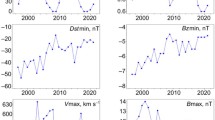Summary
Based on the six-hourly re-analysis sea-level pressure data of the European Centre for Medium-Range Weather Forecast (ECMWF) a cyclone statistics for the Arctic region north of 60° is elaborated for the period 1 November 1986 to 31 October 1991. For each low pressure center on a weather map its location, central pressure and horizontal pressure gradients in E, W, N, and S direction are determined. Furthermore, cyclone centers are followed with time to calculate trajectories, pressure tendencies, and lifetimes.
A horizontal grid of 300 km × 300 km is used as unit area for the statistical computations. A unit area experiences about 20 cyclone passages per year (range 5–40). On the average, six cyclones occur simultaneously in the Arctic region. Lifetimes vary from 6 h to 15 days.
The annual cyclone activity over the 5-year period is nearly the same. Cyclones are more frequent in summer (about 94 per month) than in winter (77 per month). In general summer cyclones are weaker than winter cyclones. On the average, the minimum central pressure during the lifetime of a cyclone is about 1000 hPa (typical range 980–1020) in summer and about 988 hPa (typical range 940–1030) in winter.
In winter, a zone of high cyclone frequency extends from the region near Iceland over the Greenland Sea, Barents Sea, and Kara Sea to the Laptev Sea while the interior of the Arctic shows little cyclone frequency. In summer, the region near Iceland and the interior of the Arctic are separate centers of high cyclone frequency. Both in winter and summer very high cyclone frequencies are observed over the northern Baffin Bay. The regional distribution of mean central pressures and maximum pressure gradients roughly follows the distribution of cyclone frequencies except for the Baffin Bay cyclones which are generally weak. Cyclolysis dominates cyclogenesis over largest parts of the Arctic. Regions of high cyclone frequency are also regions of frequent cyclogenesis and frequent cyclolysis. One third of all cyclones is generated in a region with an already existing cyclonic circulation.
Cyclones in the Fram Strait are studied in more detail because of their special impact on the ice export from the Arctic Ocean to the Atlantic Ocean. On the average, there are 5 cyclones per month. the cyclone frequency in the Fram Strait is higher during the winter period than during the summer period. This is in contrast to the overall Arctic frequency which is higher in summer than in winter. Cyclogenesis predominates in winter and cyclolysis in summer in the Fram Strait. The most frequent direction of motion is from SW to NE.
Similar content being viewed by others
Author information
Authors and Affiliations
Additional information
Received November, 1999 Revised June 22, 2000
Rights and permissions
About this article
Cite this article
Brümmer, B., Thiemann, S. & Kirchgäßner, A. A cyclone statistics for the Arctic based on European Centrere-analysis data. Meteorol Atmos Phys 75, 233–250 (2000). https://doi.org/10.1007/s007030070006
Issue Date:
DOI: https://doi.org/10.1007/s007030070006




